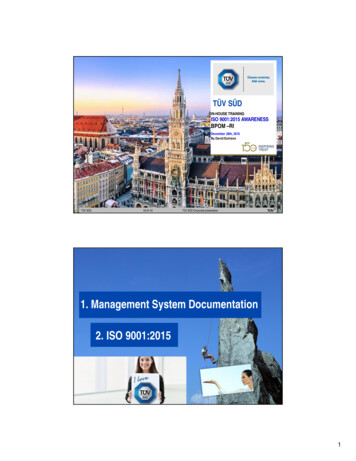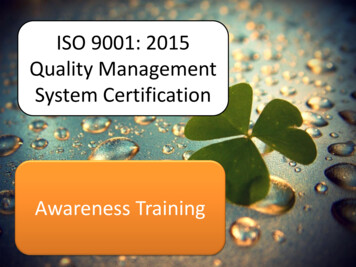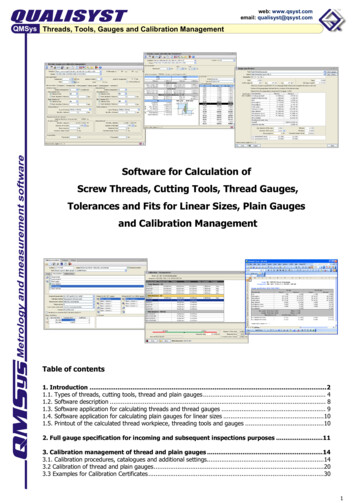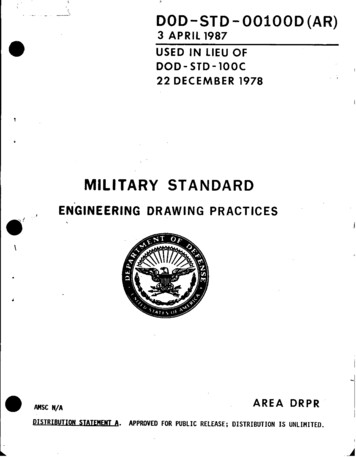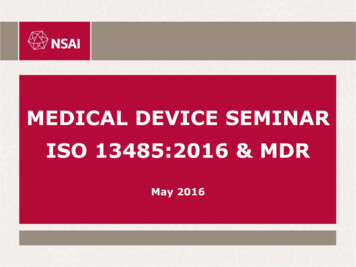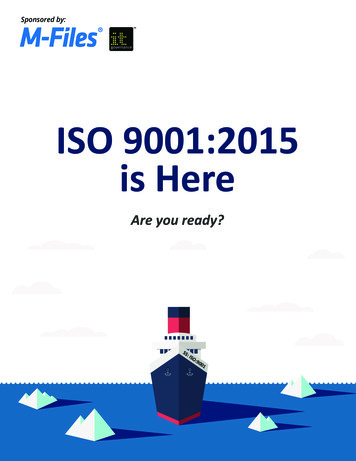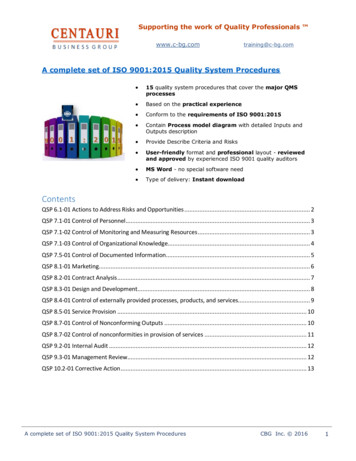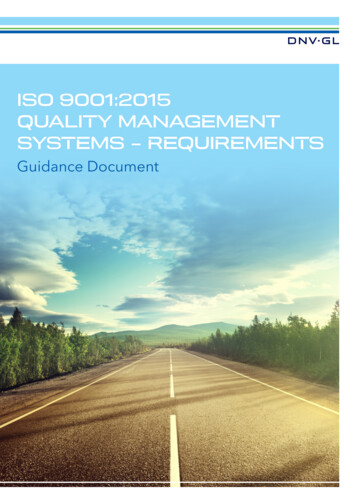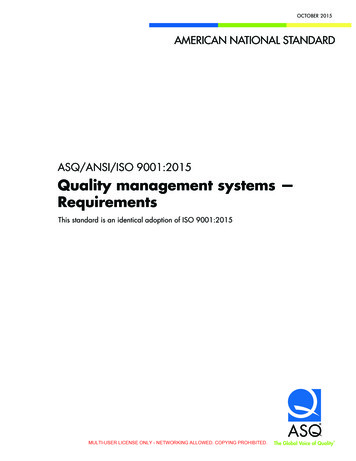
Transcription
OCTOBER 2015AMERICAN NATIONAL STANDARDASQ/ANSI/ISO 9001:2015Quality management systems —RequirementsThis standard is an identical adoption of ISO 9001:2015MULTI-USER LICENSE ONLY - NETWORKING ALLOWED. COPYING PROHIBITED.
ASQ/ANSI/ISO 9001:2015AMERICAN NATIONAL STANDARDQuality management systems — RequirementsApproved as an American National Standard onOctober 21, 2015American National Standards: An American National Standard implies a consensus of those substantiallyconcerned with its scope and provisions. An American National Standard is intended as a guide to aid themanufacturer, the consumer, and the general public. The existence of an American National Standard does not inany respect preclude anyone, whether he or she has approved the standard or not, from manufacturing,purchasing, or using products, processes, or procedures not conforming to the standard. American NationalStandards are subject to periodic review and users are cautioned to obtain the latest edition.Caution Notice: This American National Standard may be revised or withdrawn at any time. The procedures of theAmerican National Standards Institute require that action be taken to reaffirm, revise, or withdraw this standard nolater than five years from the date of publication. Purchasers of American National Standards may receive currentinformation on all standards by calling of writing the American National Standards Institute.MULTI-USER LICENSE ONLY - NETWORKING ALLOWED. COPYING PROHIBITED.i
ASQ/ANSI/ISO 9001:2015COPYRIGHT PROTECTED DOCUMENT 2015 by ASQCopyright Protection Notice for the ASQ/ANSI/ISO 9001:2015 Standard.This standard is subject to copyright claims of ISO, ANSI, and ASQ. Not for resale. No part of thispublication may be reproduced in any form, including an electronic retrieval system, without theprior written permission of ASQ. All requests pertaining to the ASQ/ANSI/ISO 9001:2015Standard should be submitted to ASQ.Note: As used in this document, the term “International Standard” refers to the American NationalStandard adoption of this and other International Standards.ASQ will consider requests for change and information on the submittal of such requestsregarding this Standard. All requests should be in writing to the attention of the Standardsadministrator at the address below.ASQ Mission: The American Society for Quality advances individual and organizationalperformance excellence worldwide by providing opportunities for learning, quality improvement,and knowledge exchange.PDF disclaimerThis PDF file may contain embedded typefaces. In accordance with Adobe’s licensingpolicy, this file may be viewed but shall not be edited or printed. In downloading this file,parties therein accept the responsibility of not infringing on Adobe’s licensing policy. ASQaccepts no liability in this area.Adobe is a trademark of Adobe Systems Incorporated.Details of the software products used to create this PDF file can be found in the General Inforelative to the file; the PDF-creating parameters were optimized for printing. Every care hasbeen taken to ensure that the file is suitable for use by our customers. In the unlikely eventthat a problem relating to it is found, please inform ASQ at the address below.Published by:iiMULTI-USER LICENSE ONLY - NETWORKING ALLOWED. COPYING PROHIBITED.
Contents PageForeword.vIntroduction. vi12345678Scope. 1Normative references. 1Terms and definitions. 1Context of the organization. 14.1Understanding the organization and its context. 1Understanding the needs and expectations of interested parties. 24.24.3Determining the scope of the quality management system. 24.4Quality management system and its processes. 2Leadership. 35.1Leadership and commitment. 35.1.1General. 35.1.2Customer focus. 3Policy. 45.25.2.1Establishing the quality policy. 4Communicating the quality policy. 45.2.25.3Organizational roles, responsibilities and authorities. 4Planning. 4Actions to address risks and opportunities. 46.16.2Quality objectives and planning to achieve them. 56.3Planning of changes. 5Support. 6Resources. 67.17.1.1General. 67.1.2People. 6Infrastructure. 67.1.37.1.4Environment for the operation of processes. 6Monitoring and measuring resources. 77.1.57.1.6Organizational knowledge. 77.2Competence. 8Awareness. 87.37.4Communication. 8Documented information. 87.57.5.1General. 87.5.2Creating and updating. 97.5.3Control of documented information. 9Operation. 98.1Operational planning and control. 98.2Requirements for products and services. 108.2.1Customer communication. 108.2.2Determining the requirements for products and services. 108.2.3Review of the requirements for products and services. 108.2.4Changes to requirements for products and services. 118.3Design and development of products and services. 118.3.1General. 118.3.2Design and development planning. 118.3.3Design and development inputs. 118.3.4Design and development controls. 128.3.5Design and development outputs. 128.3.6Design and development changes. 12MULTI-USER LICENSE ONLY - NETWORKING ALLOWED. COPYING PROHIBITED.iii
8.48.59108.68.7Control of externally provided processes, products and services. 138.4.1General. 138.4.2Type and extent of control. 138.4.3Information for external providers. 13Production and service provision. 14Control of production and service provision. 148.5.18.5.2Identification and traceability. 148.5.3Property belonging to customers or external providers. 158.5.4Preservation. 158.5.5Post-delivery activities. 15Control of changes. 158.5.6Release of products and services. 15Control of nonconforming outputs. 16Performance evaluation.16Monitoring, measurement, analysis and evaluation. 169.19.1.1General. 169.1.2Customer satisfaction. 179.1.3Analysis and evaluation. 179.2Internal audit. 17Management review. 189.39.3.1General. 189.3.2Management review inputs. 189.3.3Management review outputs. 18Improvement.1910.1 General. 1910.2 Nonconformity and corrective action. 1910.3 Continual improvement. 19Annex A (informative) Clarification of new structure, terminology and concepts.21Annex B (informative) Other International Standards on quality management and qualitymanagement systems developed by ISO/TC 176.25Bibliography. 28iv MULTI-USER LICENSE ONLY - NETWORKINGALLOWED. COPYING PROHIBITED.
ForewordISO (the International Organization for Standardization) is a worldwide federation of national standardsbodies (ISO member bodies). The work of preparing International Standards is normally carried outthrough ISO technical committees. Each member body interested in a subject for which a technicalcommittee has been established has the right to be represented on that committee. Internationalorganizations, governmental and non-governmental, in liaison with ISO, also take part in the work.ISO collaborates closely with the International Electrotechnical Commission (IEC) on all matters ofelectrotechnical standardization.The procedures used to develop this document and those intended for its further maintenance aredescribed in the ISO/IEC Directives, Part 1. In particular the different approval criteria needed for thedifferent types of ISO documents should be noted. This document was drafted in accordance with theeditorial rules of the ISO/IEC Directives, Part 2 (see www.iso.org/directives).Attention is drawn to the possibility that some of the elements of this document may be the subject ofpatent rights. ISO shall not be held responsible for identifying any or all such patent rights. Details ofany patent rights identified during the development of the document will be in the Introduction and/oron the ISO list of patent declarations received (see www.iso.org/patents).Any trade name used in this document is information given for the convenience of users and does notconstitute an endorsement.For an explanation on the meaning of ISO specific terms and expressions related to conformity assessment,as well as information about ISO’s adherence to the World Trade Organization (WTO) principles in theTechnical Barriers to Trade (TBT) see the following URL: www.iso.org/iso/foreword.html.The committee responsible for this document is Technical Committee ISO/TC 176, Quality managementand quality assurance, Subcommittee SC 2, Quality systems.This fifth edition cancels and replaces the fourth edition (ISO 9001:2008), which has been technicallyrevised, through the adoption of a revised clause sequence and the adaptation of the revised qualitymanagement principles and of new concepts. It also cancels and replaces the Technical CorrigendumISO 9001:2008/Cor.1:2009.MULTI-USER LICENSE ONLY - NETWORKING ALLOWED. COPYING PROHIBITED.v
Introduction0.1 GeneralThe adoption of a quality management system is a strategic decision for an organization that can helpto improve its overall performance and provide a sound basis for sustainable development initiatives.The potential benefits to an organization of implementing a quality management system based on thisInternational Standard are:a)the ability to consistently provide products and services that meet customer and applicablestatutory and regulatory requirements;c)addressing risks and opportunities associated with its context and objectives;b) facilitating opportunities to enhance customer satisfaction;d) the ability to demonstrate conformity to specified quality management system requirements.This International Standard can be used by internal and external parties.It is not the intent of this International Standard to imply the need for:— uniformity in the structure of different quality management systems;— alignment of documentation to the clause structure of this International Standard;— the use of the specific terminology of this International Standard within the organization.The quality management system requirements specified in this International Standard arecomplementary to requirements for products and services.This International Standard employs the process approach, which incorporates the Plan-Do-Check-Act(PDCA) cycle and risk-based thinking.The process approach enables an organization to plan its processes and their interactions.The PDCA cycle enables an organization to ensure that its processes are adequately resourced andmanaged, and that opportunities for improvement are determined and acted on.Risk-based thinking enables an organization to determine the factors that could cause its processes andits quality management system to deviate from the planned results, to put in place preventive controlsto minimize negative effects and to make maximum use of opportunities as they arise (see Clause A.4).Consistently meeting requirements and addressing future needs and expectations poses a challengefor organizations in an increasingly dynamic and complex environment. To achieve this objective, theorganization might find it necessary to adopt various forms of improvement in addition to correctionand continual improvement, such as breakthrough change, innovation and re-organization.In this International Standard, the following verbal forms are used:— “shall” indicates a requirement;— “should” indicates a recommendation;— “may” indicates a permission;— “can” indicates a possibility or a capability.Information marked as “NOTE” is for guidance in understanding or clarifying the associated requirement.vi MULTI-USER LICENSE ONLY - NETWORKINGALLOWED. COPYING PROHIBITED.
0.2 Quality management principlesThis International Standard is based on the quality management principles described in ISO 9000. Thedescriptions include a statement of each principle, a rationale of why the principle is important for theorganization, some examples of benefits associated with the principle and examples of typical actionsto improve the organization’s performance when applying the principle.The quality management principles are:— customer focus;— leadership;— engagement of people;— process approach;— improvement;— evidence-based decision making;— relationship management.0.3 Process approach0.3.1 GeneralThis International Standard promotes the adoption of a process approach when developing,implementing and improving the effectiveness of a quality management system, to enhance customersatisfaction by meeting customer requirements. Specific requirements considered essential to theadoption of a process approach are included in 4.4.Understanding and managing interrelated processes as a system contributes to the organization’seffectiveness and efficiency in achieving its intended results. This approach enables the organizationto control the interrelationships and interdependencies among the processes of the system, so that theoverall performance of the organization can be enhanced.The process approach involves the systematic definition and management of processes, and theirinteractions, so as to achieve the intended results in accordance with the quality policy and strategicdirection of the organization. Management of the processes and the system as a whole can be achievedusing the PDCA cycle (see 0.3.2) with an overall focus on risk-based thinking (see 0.3.3) aimed at takingadvantage of opportunities and preventing undesirable results.The application of the process approach in a quality management system enables:a)understanding and consistency in meeting requirements;c)the achievement of effective process performance;b) the consideration of processes in terms of added value;d) improvement of processes based on evaluation of data and information.Figure 1 gives a schematic representation of any process and shows the interaction of its elements. Themonitoring and measuring check points, which are necessary for control, are specific to each processand will vary depending on the related risks.MULTI-USER LICENSE ONLY - NETWORKING ALLOWED. COPYING PROHIBITED.vii
Figure 1 — Schematic representation of the elements of a single process0.3.2 Plan-Do-Check-Act cycleThe PDCA cycle can be applied to all processes and to the quality management system as a whole.Figure 2 illustrates how Clauses 4 to 10 can be grouped in relation to the PDCA cycle.NOTENumbers in brackets refer to the clauses in this International Standard.Figure 2 — Representation of the structure of this International Standard in the PDCA cycleviii MULTI-USER LICENSE ONLY - NETWORKINGALLOWED. COPYING PROHIBITED.
The PDCA cycle can be briefly described as follows:— Plan: establish the objectives of the system and its processes, and the resources needed to deliverresults in accordance with customers’ requirements and the organization’s policies, and identifyand address risks and opportunities;— Do: implement what was planned;— Check: monitor and (where applicable) measure processes and the resulting products and servicesagainst policies, objectives, requirements and planned activities, and report the results;— Act: take actions to improve performance, as necessary.0.3.3 Risk-based thinkingRisk-based thinking (see Clause A.4) is essential for achieving an effective quality management system.The concept of risk-based thinking has been implicit in previous editions of this International Standardincluding, for example, carrying out preventive action to eliminate potential nonconformities, analysingany nonconformities that do occur, and taking action to prevent recurrence that is appropriate for theeffects of the nonconformity.To conform to the requirements of this International Standard, an organization needs to plan andimplement actions to address risks and opportunities. Addressing both risks and opportunitiesestablishes a basis for increasing the effectiveness of the quality management system, achievingimproved results and preventing negative effects.Opportunities can arise as a result of a situation favourable to achieving an intended result, forexample, a set of circumstances that allow the organization to attract customers, develop new productsand services, reduce waste or improve productivity. Actions to address opportunities can also includeconsideration of associated risks. Risk is the effect of uncertainty and any such uncertainty can havepositive or negative effects. A positive deviation arising from a risk can provide an opportunity, but notall positive effects of risk result in opportunities.0.4 Relationship with other management system standardsThis International Standard applies the framework developed by ISO to improve alignment among itsInternational Standards for management systems (see Clause A.1).This International Standard enables an organization to use the process approach, coupled with thePDCA cycle and risk-based thinking, to align or integrate its quality management system with therequirements of other management system standards.This International Standard relates to ISO 9000 and ISO 9004 as follows:— ISO 9000 Quality management systems — Fundamentals and vocabulary provides essentialbackground for the proper understanding and implementation of this International Standard;— ISO 9004 Managing for the sustained success of an organization — A quality management approachprovides guidance for organizations that choose to progress beyond the requirements of thisInternational Standard.Annex B provides details of other International Standards on quality management and qualitymanagement systems that have been developed by ISO/TC 176.This International Standard does not include requirements specific to other management systems,such as those for environmental management, occupational health and safety management, orfinancial management.Sector-specific quality management system standards based on the requirements of this InternationalStandard have been developed for a number of sectors. Some of these standards specify additionalquality management system requirements, while others are limited to providing guidance to theapplication of this International Standard within the particular sector.MULTI-USER LICENSE ONLY - NETWORKING ALLOWED. COPYING PROHIBITED.ix
A matrix showing the correlation between the clauses of this edition of this International Standard andthe previous edition (ISO 9001:2008) can be found on the ISO/TC 176/SC 2 open access web site at:www.iso.org/tc176/sc02/public.x MULTI-USER LICENSE ONLY - NETWORKINGALLOWED. COPYING PROHIBITED.
INTERNATIONAL STANDARD ASQ/ANSI/ISO 9001:2015Quality management systems
The committee responsible for this document is Technical Committee ISO/TC 176, Quality management and quality assurance, Subcommittee SC 2, Quality systems. This fifth edition cancels and replaces the fourth edition (ISO 9001:2008), which has been technically


